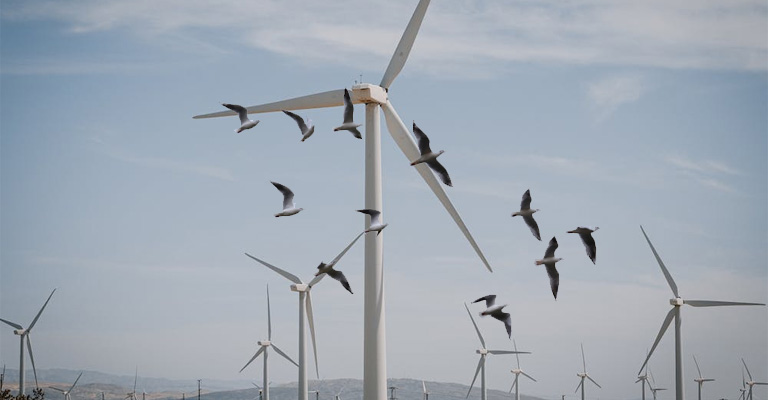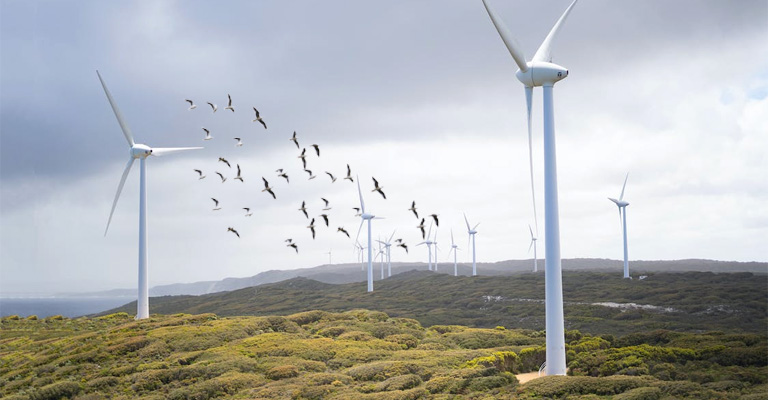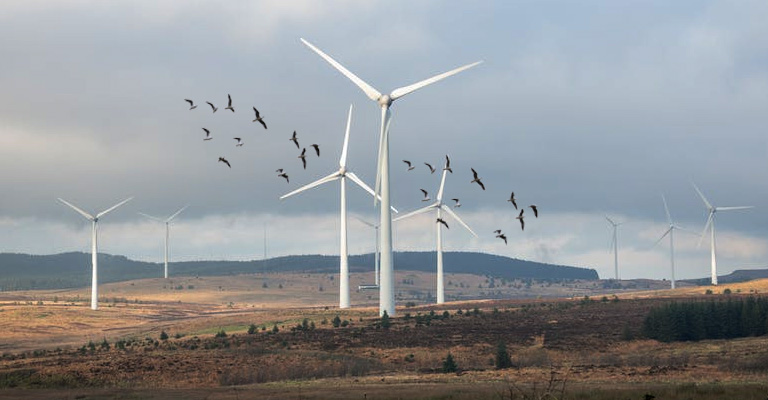Wind energy has emerged as a promising alternative to fossil fuels, with wind turbines dotting landscapes worldwide. However, an unfortunate consequence of this clean energy solution is the unintentional harm it can cause to avian populations.
Birds, known for their remarkable flight abilities, occasionally collide with wind turbines, leading to concerns about their conservation.
This perplexing phenomenon has puzzled scientists and environmentalists alike, prompting a quest to unravel the reasons behind these collisions.
In this article, we delve into why do birds fly into wind turbines, exploring the intricate interplay between avian behavior, turbine design, and environmental factors.
By shedding light on this enigma, we hope to foster a deeper understanding of the issue and pave the way for innovative solutions that can mitigate the impact on bird populations while harnessing the power of wind energy.

Why Do Birds Fly into Wind Turbines?
Birds flying into wind turbines is a tragic occurrence that has raised concerns among environmentalists and researchers.
While wind energy is considered a clean and renewable source of power, the impact it has on bird populations cannot be ignored.
Several factors contribute to birds colliding with wind turbines, and understanding these reasons is crucial for developing effective mitigation strategies. In this article, we will explore the various causes behind bird collisions with wind turbines.
Collision with Rotor Blades
One of the primary reasons birds collide with wind turbines is the physical contact with the rotating rotor blades. Birds may misjudge the distance or speed of the blades, leading to fatal collisions.
The rotor blades can reach speeds of up to 200 miles per hour, making it difficult for birds to react in time.
Disorientation and Visual Perception
Birds rely heavily on their visual perception during flight. Wind turbines, with their large rotating blades, can create visual illusions that confuse birds.
The motion of the blades can disrupt the birds’ ability to accurately judge their surroundings, leading to disorientation and increased collision risks.
Habitat Disruption
Wind turbines are often installed in areas that were previously natural habitats for birds. The construction and operation of wind farms can result in habitat loss, fragmentation, and disturbance.
Birds may be forced to alter their flight paths or navigate through unfamiliar territories, increasing the likelihood of collisions with wind turbines.
Attraction to Turbine Structures

Some bird species are attracted to tall structures, including wind turbines, as potential perching or nesting sites.
This attraction can lead to increased bird activity in the vicinity of wind farms, thereby elevating the risk of collisions.
The presence of birds near the turbines makes them more susceptible to accidental collisions with rotating blades.
Migration Patterns
Birds undertake long-distance migrations, often spanning thousands of miles. These migratory routes can intersect with areas where wind farms are located.
During migration, birds may be exhausted, disoriented, or facing adverse weather conditions, making them more vulnerable to collisions with wind turbines.
Weather Conditions
Certain weather conditions can exacerbate the risk of bird collisions with wind turbines.
For instance, low cloud cover, fog, or heavy precipitation can reduce visibility, making it harder for birds to detect and avoid rotating blades.
Similarly, strong winds can affect birds’ flight patterns, increasing the chances of accidental collisions.
Species-Specific Behavior
Different bird species exhibit varying flight behaviors, which can influence their collision risk with wind turbines. Some species, such as raptors, are known to soar at higher altitudes, potentially bringing them closer to the height of wind turbine blades.
Additionally, birds that engage in flocking behavior may be more prone to collisions due to the increased density of individuals in their flight paths.
Lack of Awareness
Birds may simply be unaware of the presence of wind turbines or the potential danger they pose. This lack of awareness can be attributed to the relatively recent introduction of wind farms in many areas.
As a result, birds may not have evolved the necessary instincts or behaviors to avoid wind turbines, leading to higher collision rates.
Efforts are being made to mitigate bird collisions with wind turbines. These include implementing radar systems to detect bird activity and adjust turbine operations accordingly.
These include modifying turbine designs to reduce collision risks, and carefully selecting wind farm locations to minimize impacts on bird populations.
How to Prevent Wind Turbine Bird Collision?

Preventing bird collisions with wind turbines is a crucial aspect of wind energy development. Here are some strategies to help minimize the impact on bird populations:
Site Selection
Choose wind turbine locations carefully to avoid areas with high bird activity, such as migration routes, nesting sites, or important foraging areas. Conduct thorough environmental assessments before selecting a site.
Radar Systems
Implement advanced radar systems that can detect bird movements in real-time. These systems can provide early warnings to shut down turbines when birds are in close proximity.
Turbine Placement and Design
Optimize the placement and design of wind turbines to minimize their visibility to birds.
Consider factors such as tower height, rotor diameter, and spacing between turbines to reduce the risk of collisions.
Lighting and Marking
Use appropriate lighting and marking systems on wind turbines to increase their visibility to birds, especially during low-light conditions. This can help birds avoid collisions.
Noise Deterrents
Install noise deterrents, such as speakers emitting bird distress calls or predator sounds, near wind turbines. These deterrents can discourage birds from approaching the turbines.
Operational Curtailment
Implement operational curtailment strategies during periods of high bird activity, such as during migration seasons or when specific bird species are known to be present in the area.
This involves temporarily shutting down or reducing turbine operation to minimize the risk of collisions.
Research and Monitoring
Conduct ongoing research and monitoring to understand bird behavior and migration patterns in the area. This information can help inform mitigation strategies and improve future wind turbine designs.
Collaboration with Experts
Work closely with ornithologists, environmental organizations, and other experts to develop and implement effective bird collision prevention measures. Their expertise can provide valuable insights and guidance.
The effectiveness of these measures may vary depending on the specific location and bird species involved. Therefore, a comprehensive approach that combines multiple strategies is often the most effective way to minimize bird collisions with wind turbines.
Can Painting Wind Turbines Black Help Protect Birds?
Painting wind turbines black is one potential strategy that has been suggested to help protect birds from collisions. The idea behind this approach is to increase the visibility of the turbine blades and reduce the likelihood of birds flying into them.
While it may seem like a simple solution, the effectiveness of painting wind turbines black in mitigating bird collisions is still a topic of debate among experts. Let’s explore the potential benefits of this approach.
Increased Visibility
Painting wind turbines black can create a high-contrast visual cue that makes the rotating blades more apparent to birds. This increased visibility may help birds recognize the presence of the turbines and avoid collisions.
Contrast Against the Sky
Black is a color that provides a strong contrast against the sky, especially during daylight hours. By painting the turbines black, they may stand out more prominently against the background, making them easier for birds to detect and avoid.
Reduced Motion Blur
The rotating blades of wind turbines can create a motion blur effect, which may make it difficult for birds to perceive their movement accurately.
Painting the blades black could potentially reduce this motion blur, allowing birds to better judge the speed and direction of the blades.
However, wind turbines are often installed in scenic landscapes, and painting them black may have visual implications.
Some argue that black turbines could be seen as intrusive or unsightly, potentially affecting public acceptance of wind energy projects.
FAQs
Yes, bird collisions with wind turbines are a significant problem. While the exact number of bird fatalities varies, studies estimate that hundreds of thousands to millions of birds are killed annually due to collisions with wind turbines.
No, not all bird species collide with wind turbines at the same rate. Certain species, such as raptors (eagles, hawks, etc.), waterfowl, and migratory birds, are more prone to collisions due to their flight behaviors, migration patterns, or habitat preferences.
In many countries, there are regulations and guidelines in place to address the potential impacts of wind turbines on bird populations.
These regulations often require environmental assessments before wind farm construction, considering factors such as bird migration routes and sensitive habitats.
Yes, technology plays a crucial role in mitigating bird collisions with wind turbines. Advanced radar systems can detect bird activity and adjust turbine operations accordingly, reducing the risk of collisions.
The long-term implications of bird collisions with wind turbines can be significant for bird populations and ecosystems. The loss of individual birds can disrupt breeding patterns, affect population dynamics, and potentially impact food chains.
Bottom Line
The phenomenon of birds colliding with wind turbines is a complex issue that requires careful consideration.
While it is true that some bird species are at risk of collision, it is important to note that the overall impact on bird populations is relatively low compared to other human-related factors such as habitat loss and climate change.
Scientists and engineers are actively working to mitigate this issue by implementing various measures, including improved turbine design, radar systems, and avian deterrents.
Thorough environmental impact assessments are conducted before wind farms are established to minimize potential harm to bird populations.
It is crucial to strike a balance between renewable energy generation and wildlife conservation.
By continuing to invest in research and technology, we can ensure that wind energy remains a sustainable and environmentally friendly solution while minimizing the impact on our avian friends.